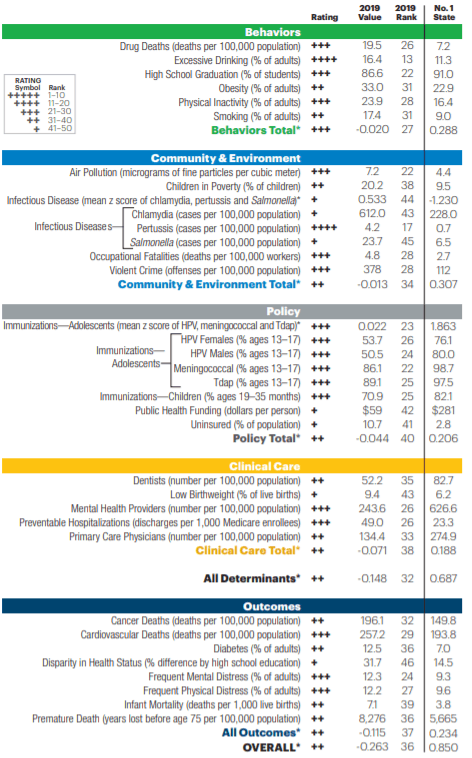Dropping Knowledge
North Carolina is the 36th healthiest state in the country, down three spots from 2018 when it ranked 33rd, according to the annual America’s Health Rankings report released by United Health Foundation in partnership with American Public Health Association. The report looks at 35 measures of health grouped into five categories (behaviors, community and environment, policy, clinical care, and health outcomes).
North Carolina ranks the lowest in the policy category, with public health funding ($59 per person) and percent uninsured (10.7%) ranking 42nd and 41st, respectively. The state also earned low marks for low birthweight (43rd) and the disparity in health status as measured by the percent difference by high school education (46th). See the full list of health measures and North Carolina’s ranking below.

The report also highlights national successes and challenges. Successes include:
- 20% decrease in percent of children in poverty since 2013
- 13% increase in number of mental health providers since 2017
Challenges include:
- 4% increase in suicide since 2018
- 37% increase in drug deaths since 2016
The Other 49
Looking to reform higher education? Keep an eye on California, according to a recent article from The Hechinger Report and CalMatters. The article, titled “Is California saving higher education?,” provides a comprehensive overview of the different measures California is taking to increase attainment. Policy measures include:
- Grants to help students almost done with their degrees graduate (similar to North Carolina’s Finish Line Grants).
- Increasing the number of transfers from community colleges to public and private universities.
- Investing $75 million last year and another $75 million this year in the state’s 23 Cal State Universities (CSU) to improve graduation rates. Schools have used this money to add popular course sections and more student advisors.
- Placing more students deemed in need of remedial education in credit-bearing courses with extra tutoring.
- Investing $50 million to deal with student hunger and homelessness.
- Providing students who are parents of dependent children with up to $6,000 a year for books, child care expenses, and other non-tuition expenses.
The article points out that, due to California’s size and student population diversity, if these reforms work in California, they probably will work elsewhere.
For Your Consideration
Does more information on school quality inherently create a more equitable school system? That is the question at the center of a new working paper by two researchers, one of whom is from Duke’s Fuqua School of Business. The paper uses the rollout of the school rating website GreatSchools.org from 2006-2015 to show that more information on school performance actually made school systems less equitable, not more.
As more information on school performance became available, affluent and more educated parents (largely white and Asian) were better able to take advantage of the information to move to neighborhoods with higher rated schools. GreatSchools ratings impacted housing prices and increased residential segregation, the analysis shows. Read more about the study and additional reporting on the issue in this Chalkbeat article.
What we're reading
The U.S. Furniture Industry Is Back—but There Aren’t Enough Workers
Companies expanding American production due to consumer preferences and tariffs are finding a dearth of skilled workers. This Wall Street Journal article takes a look at Catawba Community College's Furniture Academy. ... Read the rest-
Data: How Reading Is Really Being Taught
-
Trump Country Sees Biggest Income Dips — and Jumps
-
Renewing Philanthropy’s Commitment to Local Journalism
-
The Changing Geography of the Opioid Crisis
-
Over-the-Counter Cancer Tests?
-
With Population Booming, North Carolina District Wants to Keep Schools Open Year-Round


